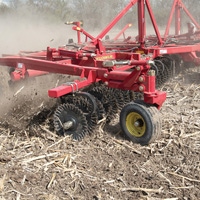March 7, 2011

DeAnn Presley thinks they’re neat. Offset rows of ultra-shallow, hybrid disc blades that slice corn stalks like Ginzu knives at speeds up to 12 mph. Presley, soil scientist with Kansas State University, has become the resident expert on this new breed of vertical tillage tools ever since she started receiving dozens of phone calls starting in 2007 from farmers asking about their merits.
“Have you ever seen one run?” Presley asks as she pulls up YouTube videos shot by farmers out of the back windows of their tractor cabs. (See Presley’s video “Eye on Agriculture Today: Vertical Tillage.") “It’s exciting. There’s just so much going on with all the moving parts.”
Roots of vertical till
Vertical tillage has been around for more than a decade. As the name implies, implements in this category enter the soil vertically to clear a straight open path for roots to grow and create rows of even crop stands that can lead to higher yields. Presley says original implements used ripper-style shanks that worked at depths from 4 to 36 in. to shatter the hard layer of soil or plow the hardpan created by the lateral movement of plow blades.
However, in the last three to four years, a new category of vertical tillage tools has emerged to conquer a different challenge — heaping mounds of crop stalks left by today’s high-yielding, genetically modified hybrids. Like the original category, this new breed of implement enters the soil vertically so as not to impede root growth, Presley says. But they work only the top 2 to 4 in. of ground using ultra-shallow, hybrid coulter-discs designed to cut up residue and anchor it to the ground to control erosion.
Their shallow working depth results in draft requirements that are lower than those for conventional disc harrows or chisel plows, which companies claim can save on fuel costs. And because they skim over the top of the ground, they can be pulled at speeds averaging 8 to 10 mph to cover large areas of ground quickly.
Multi-season use
Stan McFarlane is owner of McFarlane Manufacturing, a company that started developing vertical tillage equipment in 1995. He says the new ultra-shallow vertical tillage tools were originally designed for spring use to prepare the seedbed for planting in place of conventional disc harrows or field cultivators. McFarlane says now use has expanded to fall by farmers ankle-deep in corn stalks looking for a tool to manage residue in the spring by cutting it up and mixing it into the soil in the fall to help break it down over the winter.
“The interest has been unbelievable,” McFarlane says in reference to the McFarlane Reel Disc launched in 2007.
Kail Schoen, marketing manager with Landoll Corporation, says that in side-by-side comparisons between vertical tillage and no-till, the company has seen improved germination and more even stands with the vertical tillage tools due to quicker soil warm-up.
“Sizing and mixing a small amount of soil in with the residue will increase the decomposition process,” Schoen says. “Excessive residue levels can delay germination and cost the producer in overall yield.”
Jodi DeJong-Hughes, University of Minnesota Extension educator, has tested several of these tools to collect residue readings. She says she likes their versatility, sizing ability, and shallow working depth. And because they leave 30% residue cover, they qualify as a form of reduced tillage that can be classified as mulch till.
She says the downside is cost: “They can run you about $2,000 per foot on average.”
Growing market
Kansas State’s Presley says use of these tools is a trend largely driven by manufacturers. At least a dozen companies market these implements, and four of those companies — AGCO Sunflower, Alamo, Krause, and Konskilde — entered the market just this year.
“The number of units sold has climbed significantly in the last two to three years,” says Wade Oman, district manager with Krause Corporation. “That’s why you see a lot of manufacturers jumping into it. They see the trend and believe it is a sustaining one.”
Curt Davis, marketing manager with Krause, says all of these tools share a similar design: Gangs of hybrid coulters or discs are followed by some type of finishing attachment that breaks up clods and levels ruts to make a level seedbed. Differences can be found in blade angle, number of flutes, and concavity of the blade. (See “Vertical Tillage Buyer's Tips" in the pdf below.)
We’ve compiled the specs for just a few of these tools to help you compare your options (click on the pdf below). If you can’t swing the cost of an entire new unit, companies including Blu-Jet, Summers, Wil-Rich, and Yetter, make attachments that allow you to convert your chisel plow, field cultivator, or soil finisher shanks into an ultra-shallow vertical tillage implement. For more information about these attachments, visit www.blu-jet.com, www.summersmfg.com, www.wil-rich.com, and www.yetterco.com.
About the Author(s)
You May Also Like




